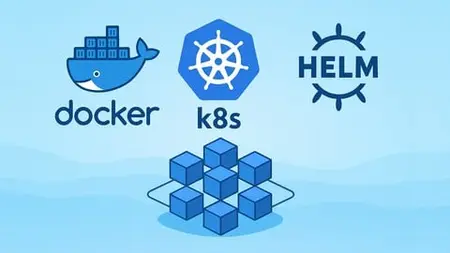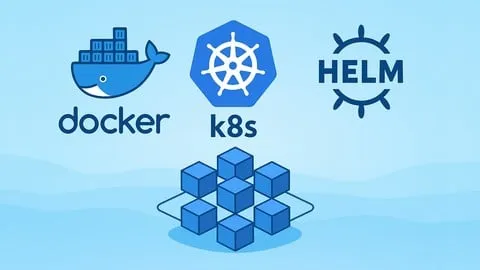Docker, Kubernetes & Helm For Beginners: Build & Deploy Apps
Published 8/2025
MP4 | Video: h264, 1920x1080 | Audio: AAC, 44.1 KHz
Language: English | Size: 1.55 GB | Duration: 4h 45m
Published 8/2025
MP4 | Video: h264, 1920x1080 | Audio: AAC, 44.1 KHz
Language: English | Size: 1.55 GB | Duration: 4h 45m
Hands-on projects: Containerize and deploy real apps to a free Kubernetes cluster
What you'll learn
Build Docker images and push them to a Docker registry.
Create a free Kubernetes cluster and deploy applications to it.
Understand key Kubernetes concepts: pods, services, deployments, ingress, ConfigMaps, cron jobs, and autoscaling (HPA).
Set up horizontal pod autoscaling and manage sensitive data using Kubernetes Secrets.
Create and install custom Helm charts to simplify Kubernetes deployments.
Requirements
Basic knowledge of the command line (e.g., running commands in a terminal)
Familiarity with any programming language (Node.js, PHP, Python, etc.) — no advanced experience required
Description
Are you ready to take your first step into the world of cloud-native development and DevOps?If you’ve been hearing about Docker, Kubernetes, and Helm but aren’t sure where to start, this course is designed just for you.Containers and Kubernetes are among the most in-demand skills in the tech industry today. Companies of all sizes — from startups to global enterprises — are moving their applications to containers and orchestrating them with Kubernetes. Helm has become the industry standard for managing Kubernetes applications efficiently. Learning these tools will not only make you more productive as a developer but also open doors to high-paying DevOps and cloud engineering roles.This beginner-friendly, hands-on course will guide you step by step — no prior container or Kubernetes experience required. You’ll start with the basics of Docker, learn how to package and run applications in containers, and then progress to deploying real apps on a free Kubernetes cluster in the cloud. Along the way, you’ll discover how Helm simplifies deployment and management of complex applications.What you’ll learn in this course:Docker fundamentals: build and containerize applications with DockerfilesLocal development: run, connect, and manage multiple containers on your machineKubernetes basics: understand Pods, Deployments, Services, and IngressReal-world deployments: deploy applications to a live Kubernetes cluster at no costScaling and reliability: scale workloads, update apps without downtime, and ensure resiliencyHelm essentials: use and create Helm charts to automate and simplify deploymentsDevOps best practices: apply techniques used by professionals to manage apps in productionBy the end of this course, you’ll know how to build, deploy, and manage modern applications with confidence. You won’t just understand the concepts — you’ll have the hands-on experience to prove it.Why take this course?Beginner-friendly: No Kubernetes or Docker knowledge required. Clear explanations and guided examples ensure you don’t get lost.Hands-on learning: You’ll build and deploy real projects step by step, not just watch slides.Free resources: Deploy apps to a real (and free) Kubernetes cluster.End-to-end coverage: From Dockerfiles to Kubernetes to Helm, you’ll see the full workflow in action.Career-focused: Gain practical skills that are in high demand for DevOps, SRE, and cloud engineering roles.Whether you’re a developer, student, sysadmin, IT professional, or aspiring DevOps engineer, this course gives you the foundation you need to start working with containers and Kubernetes right away.If you want to learn Docker, Kubernetes, and Helm in a practical, beginner-friendly way — and actually deploy apps to a real Kubernetes cluster — this is the perfect course to get started.
Overview
Section 1: Introduction
Lecture 1 Introduction
Section 2: Docker Essentials: Build, Share & Run Containers
Lecture 2 What Is Docker and Why Use It?
Lecture 3 Build and Run Your First Node.js App in Docker
Lecture 4 Essential Docker Commands
Lecture 5 Build a More Advanced Docker Image for a PHP App
Lecture 6 Publish and Run Your Docker Images with Docker Hub
Lecture 7 Multi-Container Apps with Docker
Lecture 8 Docker Compose - Multi-Container Apps Made Simple
Lecture 9 Docker Recap
Section 3: Kubernetes Essentials: From Cluster to Production
Lecture 10 What Is Kubernetes and Why Do You Need It?
Lecture 11 Creating and Connecting to a Free Kubernetes Cluster
Lecture 12 Create Your First Pod in Kubernetes
Lecture 13 Expose Your App with Kubernetes Services
Lecture 14 Manage Your Apps with Kubernetes Deployments
Lecture 15 Automatic Pod Scaling with Kubernetes Horizontal Pod Autoscaler (HPA)
Lecture 16 Managing App Configuration in Kubernetes: Env Vars, Secrets & ConfigMaps
Lecture 17 Using Private Docker Images in Kubernetes
Lecture 18 Health Probes in Kubernetes: Readiness, Liveness, and Startup Explained
Lecture 19 Rolling Updates and Rollout Strategies in Kubernetes
Lecture 20 Routing Web Traffic with Ingress in Kubernetes
Lecture 21 Running Tasks with Jobs and CronJobs in Kubernetes
Lecture 22 Kubernetes Recap
Section 4: Helm Essentials: Simplifying Kubernetes Deployments
Lecture 23 Helm Basics: Why You Need It and How to Get Started
Lecture 24 Installing and Managing a Helm Chart
Lecture 25 Creating Your Own Helm Chart
Lecture 26 Helm Chart Expansion - Advanced Features
Lecture 27 Sharing Your Helm Chart: Publishing and Installing via OCI Registries
Section 5: Course Recap
Lecture 28 Docker, Kubernetes, and Helm — Bringing It All Together
Beginners who want to learn containerization and orchestration from scratch,Developers interested in deploying and managing applications using Docker and Kubernetes,DevOps enthusiasts starting their journey with Helm and cloud-native tools



